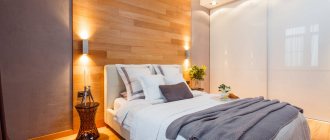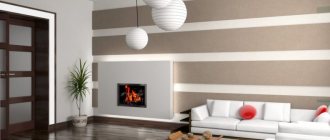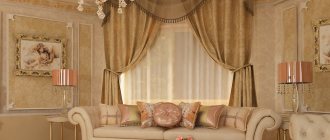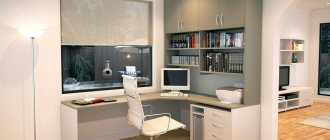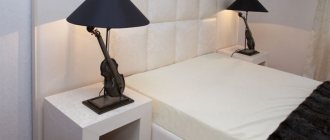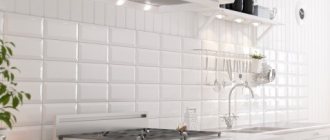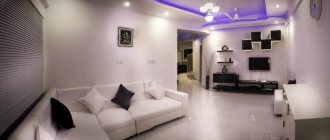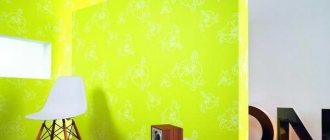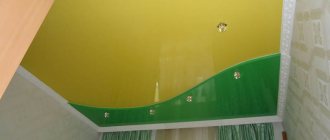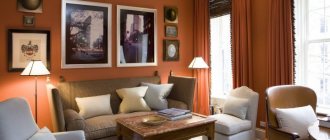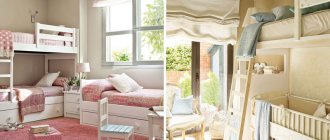The living room is rightfully considered the center of the apartment and house, since it is here that family and friends gather for rest and relaxation after a working day. For a good mood, relief from nervous tension and complete distraction from everyday life, the color of the walls in the living room is selected taking into account a number of rules used by professional designers around the world.
Features of choice
A correctly selected color scheme can visually make a room larger and more spacious, fill it with light, support the overall concept, and even eliminate some of the shortcomings of the room.
Criteria for color selection
- Features of lighting. Dim lighting can be corrected by using bright, light palettes that distribute light evenly and eliminate dark corners. If natural light enters the room in sufficient quantities or even in excess, preference should be given to cool, calm tones.
- Design and personal preferences. First of all, the color of the living room should be liked by its owners. In addition, if a certain style concept has already been chosen in a design project, it must be adhered to.
- Functionality requirements. The color of the finish can often act as a tool for zoning space instead of massive partitions or furniture groups.
- Living room area. A spacious room opens up more opportunities for realizing bright ideas. Here you can create a contrasting finish, or use smooth transitions. Small living rooms require the use of light colors and neat accents that will harmonize with other interior details.
Not all walls have to be painted the same tone, but there should be balance in everything. The finishing of the floor and ceiling is pre-thought out so that all surfaces fit well together.
How to paint the walls in an apartment with your own hands
Painting walls with your own hands allows you to significantly reduce your spending budget during the renovation process. You can experiment with colors and textures, and if you approach this task creatively, in just a couple of days you can turn an ordinary apartment into a work of your own design art.
Of course, you should start with choosing the paint itself. The modern market offers a variety of textures and colors, but the main thing you should pay attention to is performance characteristics. Especially if you plan to paint the walls in the bathroom or kitchen. Most decorative paints will give you many undeniable advantages both while working with them and in further care.
Particularly practical is painting walls with water-based paint. Its main advantage is its versatility, ease of application, and long service life (more than 10 years). Thanks to the vapor permeability of this coating, you will get a healthy microclimate in the room.
Another advantage of using water-based paint is that it mainly comes in white color. You create the required shade yourself by adding special dyes, so-called tints. Choosing a color scheme that will match and harmonize with the overall space is the next important step when painting the walls in a room.
Influence on the choice of cardinal directions
Any palette can manifest itself differently depending on the degree of natural light. This factor depends not only on the size of the window openings and their openness, but on the side of the world from which the room is located.
- South. Often there is not only enough sunlight, but also in excess. In order to reduce the “temperature”, it is recommended to use moderately cool shades (white, blue, turquoise, gray).
- West. During the daytime peaks, the room may be too hot and light, so there should be cool shades, such as mint (closer to blue), deep blue, gray, brown.
- East. It is recommended to give preference to pink and brown tones, which will benefit from the sunrise and compensate for its lack in the afternoon.
- North. Due to the coldness and short duration of sun hours, you need to choose warm, soft shades (beige, coffee, green, yellow). They will not only add light to the room, but also visually fill it with sun.
Before choosing the color of the walls for the living room, you need to consider the location and intensity of the lighting fixtures. If they are located around the entire perimeter of the room (in the form of LEDs or built-in lamps), the tint palette can be changed depending on the desired effect.
Emulsion paints
There is no unpleasant odor when working with the composition; other types of materials can be applied to the resulting surface. Emulsion paints are a homogeneous composition of antiseptic, thickener, fillers and latex. This dispersion, after drying, forms a durable, uniform coating.
Acrylic color is used for painting walls in apartments in rooms with low humidity. Does not change color when exposed to sunlight. The latex type is abrasion resistant and will hide small surface cracks. It can be used for painting wallpaper and plaster.
The water-based composition has the following features: there is practically no smell when painting, and it dries quickly. Silicone paint is flexible and can be used on any surface.
Feng Shui in the color scheme of the living room
The use of Eastern teachings when choosing interior colors allows you to determine the direction of vibration and energy, which will have a positive effect on a person’s mental and physical health. The teaching is based on the basic elements: Wood, Fire, Metal, Water and Earth. In this case, the finishing should be placed on smooth, even walls so that nothing interferes with the movement of positive energy.
Characteristics of Feng Shui flowers
- White. Symbolizes ideal, purity, light. For comfort and warmth, use in combination with another palette. An excellent solution is to add yellow tones.
- Red. The color of passion, activity, movement. It stimulates the appetite, but can sometimes cause attacks of aggression. When combined with gold, it attracts good luck. Red doesn't go well with black. The palette is not recommended for use by people with diseases of the nervous system.
- Orange. Combines the positive energy of yellow tones and the power of red. Conducive to a pleasant conversation in the guest room, attracts prosperity and kindness.
- Gold. Denotes respect, honor, status. Previously, only rulers could use this color in the interior. The golden palette has a positive effect and attracts money energy.
- Black. In fact, it is not considered a mourning color, but a magical color according to Chinese teachings. But many still equate it with negativity, so it is better to minimize the use of black or use it for accents.
- Blue. The main association is water. The palette has a calming effect, restores harmony, relaxes and is suitable for meditation. Blue stimulates spiritual energy and intuition.
- Green. The color of calm, peace, nature. It stimulates wealth and well-being, means life, growth, harmony with others. Pairs well with yellow and gold colors, creating the energy of success.
- Yellow. Symbolizes positive energy, success, happiness. It attracts warmth and makes the living room cozy, evokes an optimistic mood, and attracts good luck.
- Violet. It has mystical, magical properties. Suitable for creative people, symbolizes material well-being.
When choosing not one, but several wall colors in the living room interior, it is important that they indicate one direction to enhance energy. You should be guided not only by the above characteristics, but also by your own preferences in order to create a cozy interior.
Textured paint
When decorating interiors, you can create a relief surface on the walls. To do this, use textured paint, which will help add original elements to the design of the room. The viscosity of the composition allows you to maintain the resulting relief.
Textured paint is produced on the basis of acrylic and polymer components. It includes components that, during the application process, form a relief surface.
This paint will mask minor surface defects and can be washed. It differs in thickness, so it is applied with a spatula, roller, or brush.
Optimal solutions
Gray background
A modern, popular palette that is suitable for both classic and loft, minimalism, and modern styles. For greater effect, it is complemented with geometric textures. Thanks to the variety of shades, it is suitable for rooms of different sizes.
Yellow scale
When choosing, you should pay attention only to pastel and calm shades, and not bright and flashy shades, which will negatively affect your relaxation and cause nervous tension. Sunny, warm yellow is associated with summer and comfort. In spacious rooms it can be used for all walls, in small living rooms - for interesting accents in decor, photos, etc.
Brown tones
Mainly used for classic solutions. More saturated and deeper shades are chosen for accents, coffee, chocolate, etc. for the background.
Olive shade
Well suited for Provence, Scandinavian style, country. A soft, natural, pastel shade of green is suitable for rooms of different sizes and locations. The noble tone gives coziness and comfort and goes well with other soft tones.
Light orange
Associated with rich summer colors. It is used for various interior solutions and will become the highlight of a mixed style of classic and modern. Pairs well with turquoise and gray. Looks good in dark living rooms with windows facing north. It also compensates for the lack of lighting.
Shades of beige
A popular, versatile, practical color that can be used to decorate any living room. The room will be warm and harmonious. For decoration, bright, rich colors, imitation brickwork, and textured plaster are used.
Shades of turquoise
The turquoise palette will give you a feeling of freshness, freedom, and spaciousness. The shades are presented both rich and deep, and pastel, fresh. It goes well with different color options without overloading the interior. Makes a cool palette softer and more appropriate. More suitable for spacious rooms, plays well as accents.
Natural shades of green
A natural, comfortable palette that symbolizes life. Various shades are used in the living room interior. Often gamma is used to zoning space. Pairs well with shades of gold, brown, and floral prints.
White background
Strict and restrained, but at the same time, a neutral color that can be used as a base for any style. Its color palette is wide and varied, and textured application will open up new facets of white. The palette visually expands the room, fills it with light and warmth, and eliminates dark corners.
Advantages and disadvantages
Painting walls was previously considered the most durable coating of all existing ones, therefore it was often used by builders and at some time was undeservedly forgotten. But modern designers are reviving this finish and, using a variety of compositions, create masterpieces in interior design.
Like any building material, there are pros and cons to using paint, but most professional interior decorators tend to use it.
Advantages of using paint in design:
- a large selection of colors allows you to create bright and non-standard combinations;
- safety of use, the compositions do not emit harmful substances;
- variety in surface decor and harmonious combination with different textures;
- versatility of use, the paint can be matched to any type of room: bath, bedroom, kitchen, corridor;
- resistance to mechanical damage and contamination;
- easy maintenance, painted surface is easy to clean;
- the ability to create a unique design with your own hands.
These are not all advantages, but painted surfaces also have their disadvantages. They must be taken into account when choosing this type of finish. Painting requires a perfectly flat surface before application, otherwise the slightest irregularities and defects will be noticeable. If the application technology is violated and the paint composition is incorrectly chosen, the coating will quickly begin to lag behind the walls or lose its original color.
Characteristic stylistic palettes
- Contemporary. Modern style allows you to use more bright colors such as blue, turquoise, emerald, lilac, etc. A combination of several contrasting colors in one room is typical.
- Scandinavian. The style is characterized by the use of beige, gray and white tones, as well as shades of blue. The color should be harmonious and maintain spaciousness.
- Classic solutions. These directions are characterized by muted, calm colors of brown, green, and blue. Only one shade is used in the interior; patterned wallpaper is used for accents.
- Loft. A modern solution for decorating a living room. Mainly cold, calm tones are used for the interior. Gray and white go well with brick. For such an “industrial” idea, you can use black.
- Country. A rustic theme is impossible without natural shades such as brown, green, soft yellow, blue, peach, olive, etc.
- Provence. The base is pastel colors such as olive, beige, lavender, etc. It has a natural, restrained palette.
The palette of each style may vary depending on the functional purpose of the color, the area of the room, and personal preferences. If, according to the design project, the implementation of non-standard tones is appropriate, there are no restrictions for bringing such an idea to life.
Shade combinations
In old typical buildings, where the living room is a small room with low ceilings, it is better to choose a palette of cool colors to dominate. They will help to visually expand and enlarge the space. For spacious apartments or houses, an excellent solution is a living room in warm colors, and use cold colors as auxiliary ones for decorating textiles or accessories.
The color design of the walls allows you to visually adjust the dimensions of the living room
An excellent non-trivial option for combining colors in the living room: gray, emerald, yellow. It is better to choose gray as a base, and some accents of yellow or emerald will add notes of warmth, comfort and joy.
The color yellow is subconsciously always associated with something pleasant and warm.
In tandem, white, brown, red - white will dull the brightness and activity of red, which is best used in textiles. Brown goes well with wooden furniture.
White walls will become the basis for the character of the interior, and brown accents will add variety and soften the “hospital” atmosphere
Another color option for the living room: gray, beige, blue. Gray is used as a basis, blue is used as an additional relaxation, which in turn will emphasize and enhance gray. If you combine them with a warm beige shade, it will bring homeliness to the space.
Modern living room in gray, the effect of which is balanced by accents in blue tones
Types of color combinations
- Contrast. This color combination is used to implement modern interiors. You can choose the most unexpected colors if you place them correctly in the room. Use options - accent wall, geometric patterns, stained glass or panel effect, etc.
- Neutral combination. Opens up ample opportunities for the implementation of original ideas. Delicate shades are suitable for classics, for modern solutions - cooler palettes.
- Monochromy. The use of one color scheme allows not only to visually preserve the area, but also to expand it. There are many combinations, since each color can have dozens of shades. Without overloading the interior, you can zone the space.
- Two colors. The use of two different colors is acceptable for spacious rooms, but other solutions can be considered if both shades are light. It is important that the colors chosen are from one half of the spectrum. The transition is smooth, the gradient method is popular.
The use of several combinations is possible only if the living room area is 25 square meters or more. Then one of the zones can be decorated for relaxation in soothing colors, the other can be decorated for receiving guests, etc.
Photo of painting walls in the interior of rooms 2022
Despite the abundance of available wall finishing materials, painting still remains relevant. Still, accessibility and simplicity of design are not an empty phrase for most owners. However, one should not think that this is where all the benefits of paint end. In fact, it is one of the most effective and expressive ways to give your interior a memorable personality. At your disposal are all the colors of the rainbow and countless shades that can create the necessary mood and atmosphere in your apartment or house. Meanwhile, very often the walls in an apartment are painted in two colors. And today you will find out why this is not a desire to complicate the color scheme of the room, but a deliberate move to create a catchy and remarkable design. Photos with popular ideas will come in handy.
Choosing colors for a small living room
To decorate a small living room, light, calm colors are used that will be in harmony with other interior elements. It is better to avoid patterns and prints, as they may make the room seem smaller. Decorative items and furniture are used for bright accents.
To visually enlarge the room, you need to think about a lighting scheme that will highlight the color of the walls, and also hang mirrors. If you use wallpaper or decorative plaster, they should be discreet, monochrome, without unnecessary details that could negatively affect the visualization of the space. An interesting solution could be to paint an accent wall in a different shade, if you choose the right color.
Tips for choosing paints for painting walls
Characteristics of paints that are important to know:
- To paint indoors, you only need interior paints, the packaging of which is marked “for interior use.”
- The way paint interacts with water affects its use in various rooms: rooms with high humidity (bathroom, kitchen) need moisture-resistant paint. For other rooms, where there is no dampness and moisture, you can use non-moisture resistant paints.
- All coloring materials are also divided into two groups: breathable and non-breathable. Vapor-proof (non-breathable) paints should be chosen only for rooms where you plan to spend little time. The walls in the bedroom, for example, are painted only with vapor-permeable paint. This is the key to healthy circulation and air renewal.
- Wear resistance. This is an important indicator of paint, which shows the degree of its resistance to abrasion. For example, if you plan to frequently wet-clean walls, then the paint should be wear-resistant. Hiding power, that is, the ability of paint to cover a surface. This directly affects its consumption.
- The hiding power on the can indicates how much of this paint is needed to cover 1 square meter of surface.
Photo gallery
Our gallery features photographs of completed projects demonstrating the correct use of color for living room walls.
Preparing the walls
One of the main stages of work is surface treatment before applying the coloring composition. Before this, the previous coating must be removed and wall defects will be erased. Then you should clean the surface from dust.
Many people, before purchasing a color scheme, are interested in the question of how to prepare walls for painting. Puttying the walls will be a mandatory operation. It consists of two stages.
First, starting putty is applied to a special mesh. After drying, it needs to be rubbed. Then the finishing putty is applied.
Then the surfaces are primed. It is necessary to fill defects and strengthen the adhesion of the composition to the wall. After applying the primer, you should wait for it to dry completely.
